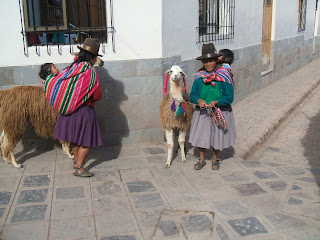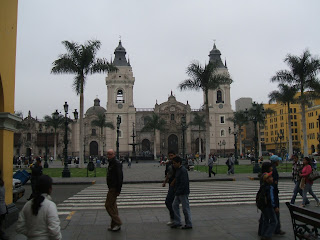I have to admit that I am not the world's best speller. Add in a second language that frequently differentiates its cognados often by as little as a letter coupled with my sometimes poor attention to detail and, boy, do you have a mess on your hands. So, imagine my confusion when traveling to what I believed to be Cuzco, Peru, but finding Cusco written as its name on my travel itinerary (created in in America) and then...going on a tour only to be told that technically Cuzco is really Qusquo (originally qusquo wanka or, rather, "rock of the owl"), a Quechua word that is derived from another indigenous language of the area called Aymara. And, if that weren't enough, when the word came directly out of the mouth of my Quechua guide, my American ear heard "Costco" and thought hmm...when I lived in Mexico they had a Costco (American superstore), could Peru have one too? Thank goodness the voice of reason stepped in and let me know that it was just a coincidence so that my wandering mind didn't miss anymore of the tour! Qué tonta estoy…
So, what it is? Cuzco, Cusco, or Costco? Well, of course, like any place that was inhabited well before the Europeans showed up, this city had an indigenous name that was taken and mispronounced by the Spanish, forever to deviate just slightly from its original form. As far as the spelling is concerned, with a little investigation, I found that both Cuzco and Cusco are considered to be acceptable spellings in English, but that the Cusco is primarily in Peru itself. I guess you say tomato, yo digo tomate...
I was fortunate to visit Cuzco twice during my trip, on my second day of my time in Peru and then again after my trek/visit to Machu Picchu on the way to Puno. People had prepared me in Lima to be wary of the change in altitude as I was traveling from sea level to 11,200 feet. Wow! I was a little fearful as I had done a lot of research with the help of Ms. Picard, but had never experienced anything of the sort. I had almost forgotten about it until the flight attendants walked around on the small plane I was taking from Lima to Cuzco and the two Argentinian women next to me ordered te de mate and I realized that it was time to start the preparation. I quickly told the attendant that I wanted lo mismo and gulped down my first cup of the tea made with coca leaves (not to be confused with cocoa the bean that makes chocolate). These leaves are chewed by the local people and they sell everything from tea, cookies, and our favorite on our later trek, candy.
I finished my tea and returned to my book for a little while before the commotion started. All of a sudden, I began to hear all kinds of chatter in Spanish and Portuguese around me (English was interestingly absent) and people moving to the windows. At first, I had a little moment of panic as the story I'd seen in movie format, Alive, about an ill-fated flight filled with Uruguayan rugby players that crashed in the Andes in 1972 and left them looking amongst themselves for food if you know what I mean popped into my head, but, alas, after putting down my book and tuning in, I luckily felt a huge sense of relief followed by absolute elation. Turns out that we were slowly beginning our descent through the clouds and the people on the plane had gotten their first glimpse of the Andes...
 |
| The sight from my airplane. |
It was an absolutely amazing sight to behold.
When I touched down in Cuzco, a representative and driver from the company I'd used to set up the trip met me at the airport and took me to my hotel...or, at least close to it. Turns out, you couldn't really drive up to my hotel, but you could hitch a ride to the bottom of a serious set of steps next to a waterfall, then turn the corner, walk up another set of steps, then turn the corner again, and walk down the street to the hotel, Casa de Campo. Upon arrival at the hotel, you guessed it...there were even more steps! Oh my goodness! There were so many steps! But, I quickly learned that the first thing you'll notice about Cuzco is that there are tons of steps. The second thing you notice is that Cuzco rewards you for your climb with the most amazing views. Here are a few from my hotel.
 |
| The waterfall next to the first set of stairs before the first turn leading up to the second set of stairs before the second turn leading to the short walk to my hotel from the bus. :) |
 |
| The other option of getting up to my hotel. Oh, those steps... |
As you can imagine, I was super-excited to be in Cuzco on my first day and after dropping off my hiker's pack at my hotel, I just couldn't stay put. I had a couple of hours to spare before needing to be back in order to be picked up for my city tour of Cuzco and the ruins of Sacsayhuaman (to be discussed in its own blog entry later). I decided that one can never have enough te de mate to ward off the potential altitude sickness (especially now that I discovered that it tastes no different than regular black tea) and headed to a local cafe to get some lunch. While there, I also met a little friend...
After lunch I headed out on a city tour. I walked the streets with a small group of fellow English and Spanish speakers for a bilingual tour. We toured the cathedral, saw the convents, and old buildings that line the city square, La Plaza de Armas. The cathedral in Cuzco does not permit photography inside but I do have a couple of interesting comments and tid-bits. First, the interior of the cathedral is very eery as all the walls are a dark slate gray. It's smaller than the one I had seen in Lima and constructed in a completely different style. Secondly, we learned something very interesting about the artwork. Much of the religious artwork in the cathedral was painted by indigenous, not Spanish, artists and also has a very distinct style. Turns out that the indigenous people, the Quechua, did adopt Catholicism, but found it difficult to completely let go of their roots. In the Quechua religion, the mountain is an important symbol or figure, I believe having to do with Pachamama (one of their gods of the earth-the monotheistic aspect is a little foggy here having heard a couple of different versions along the way). Artists commissioned to create paintings depicting the Virgin Mary, a central figure in the Catholic religion, chose to paint her in the shape of a mountain (envision the angel at the top of a Christmas tree) as a nod to their indigenous religion. As you walk around and look at the paintings inside of the cathedral, there is a marked difference between those created by Quechua and those created by Spanish painters.
As we walked around from place to place in the city, I have to admit that one of the most impressive details that you can't help but notice is the sky. The sky on both days that I spent in Cuzco was absolutely amazingly blue and clear.
 |
| The flag of Cuzco (it has not other affiliation). |
Another interesting feature that surely makes it into the collection of photos taken by the tourists who visit Cuzco is the carving of Viva el Peru Glorioso on the side of a hill/mountain on the outskirts of the city. I don't remember hearing where it came from specifically while on my tour, but a nice young high school student from Cincinnati, Ohio and I struck up a conversation on my second round in Cuzco about the hill. He was spending a large part of the summer in Peru as part of a program for high school students through National Geographic Magazine (now, that's surely a summer job I should look into!!!). He told me that he was studying photography and writing and I revealed that I was a Spanish and history teacher from Philadelphia. Unfortunately, the teacher in this case did not have the answer to the student's question of, "So, what's up with that hill?" and could only offer the logical solution of, "You know, you should Google it..." And, just like a diligent student, he did. :) Unfortunately, however, it's difficult to get a straight answer on the Internet (and remains so as I sit here back in Philly fact-checking). Most versions offer the explanation that it's nothing official, may have some commemorative value, and was done unofficially by the locals. Whatever the truth may be, it's still pretty cool and a little curiosity in the communal dining room at our shared lodge in Cuzco brought together a student from Cincinnati and teacher from Philly to relieve a tiny little bought of homesickness in that moment .
 |
| You can see the carving of Viva el Peru in the background on the hill. |

 |
| A local market in Cuzco. |
Ok, I think that's enough for now. There is much to say about all aspects of my trip and I may return for updating at a later time. I think, however, many of these photos speak for themselves.
If anyone is curious to learn a little more about Cuzco, don't hesitate to head to the oh-so-reliable Wikipedia (wink, wink) link: http://en.wikipedia.org/wiki/Cuzco. I do have to admit that there are a few really cool pictures there, including a photo of La Plaza de Armas as night. It's pretty spectacular.
I also think that some of you might enjoy the following link to a really cool series about a family that travels the world with their two kids ("Travel with Kids" series-love it!!!). My way up to Machu Picchu was far less luxurious. As you look at the scenery, notice the terrain that I walked across for 4 days over 60 km. The Inca Trail, mentioned in the following video, was not the one that I took. Mine was called the Salkantay Trek and was much, much more rigorous.

















































